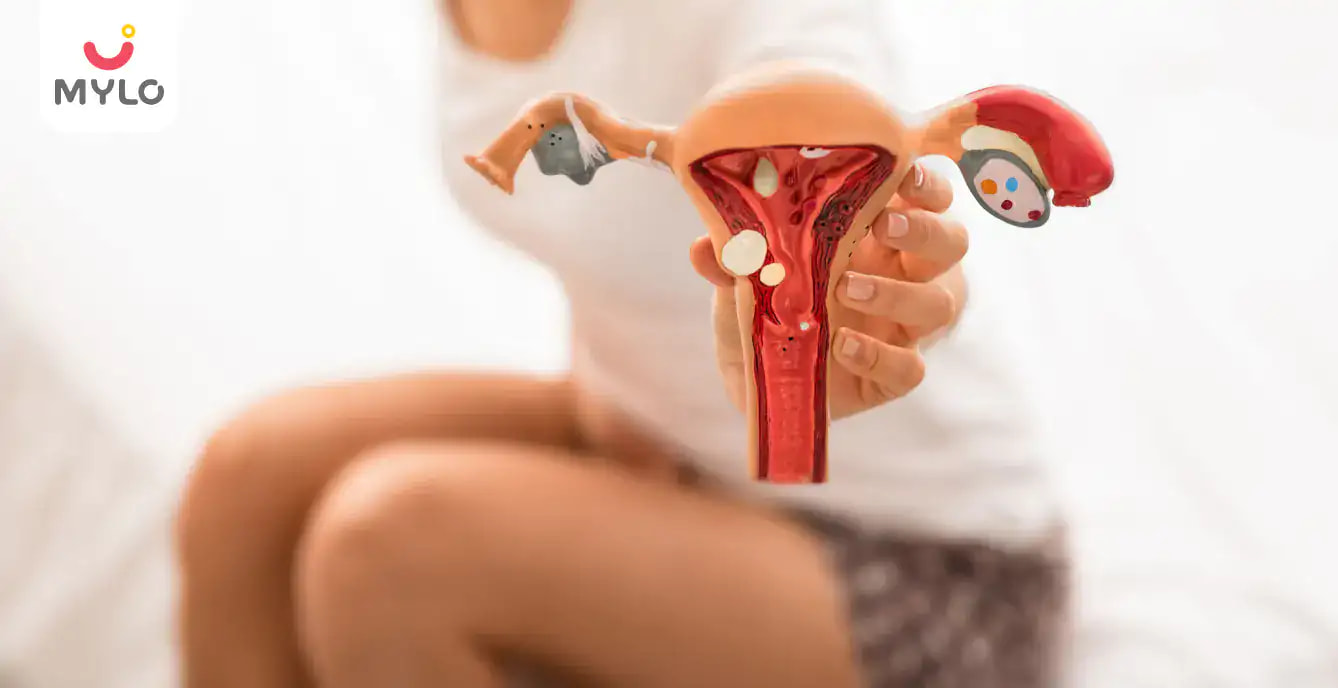Home

Fibroids

Uterine Fibroids: Meaning, Causes & Prevention
In this Article

Fibroids
Uterine Fibroids: Meaning, Causes & Prevention
Updated on 3 November 2023
Uterine fibroids or fibroids are common non-cancerous tumours that grow in a woman's uterus. These fibroids generally appear in women who have reached the childbearing age, i.e., 30-40 years. But it can grow in women of any age. There is not much about uterus fibroid symptoms because some women suffering from fibroids often show no symptoms. At the same time, some women can experience symptoms like heavy periods, severe back pain, and painful intercourse.
What are Uterine Fibroids?
Uterine fibroids or leiomyomas or fibroids are non-cancerous growths found in the uterine region. These are made of connective tissues and muscles. Uterine fibroids rarely lead to uterine cancer, so one does not need to worry too much about it. These fibroids occur in different sizes, ranging from the size undetectable by the human eye to the size of a bulky mass that can alter the size of the uterus.
One can have single or multiple fibroids in the uterus. These fibroids are commonly detected during a pelvic exam or a prenatal ultrasound. Once detected, it can be treated using different medical procedures.
Uterine Fibroids: Signs & Causes
Uterine fibroids symptoms vary from woman to woman. Some may experience mild symptoms, while others face extreme discomfort. Some of the common uterine fibroid symptoms are as follows:
- Heavy periods
- Periods usually last over a week
- Frequent urination
- Consistent constipation
- Back and leg pain
- Painful intercourse
- Chronic vaginal discharge
- Bloating
You may also like: Ovarian Cyst: Types, Causes, Symptoms and Treatment
There is no answer to the question — "What causes uterine fibroids to grow?". However, research and clinical studies believe these are the causes of uterine fibroids:
- Genetic changes
- Imbalance of estrogen and progesterone hormones
- Substances responsible for the proper growth of tissues in the body can lead to the growth of fibroids.
- The extracellular matrix responsible for binding the body cells is one of the growth factors in fibroids, as fibroids have more ECM than normal body cells.
What Does Uterine Fibroid Pain Feel Like?
Women with uterine fibroids will face various uterus fibroid symptoms, most of which are painful. However, if a woman has small fibroids that can't be seen with bare eyes, they would not feel any discomfort. For women with larger fibroids, severe pain in the back and pelvic region is common.
One might also feel pain during sex and sharp aches in the abdominal region. To make things worse, one may also experience severe menstrual cramps. Periods are also irregular and often longer in women with fibroids, so one cannot say how long these cramps may last.
You may also like: Top 10 Health Issues Related To Women
How are Uterine Fibroids Diagnosed?
Doctors and healthcare professionals can detect uterine fibroids on several occasions during regular pelvic exams. Uterine fibroid symptoms in initial diagnosis usually alert healthcare personnel who suggest some tests to confirm the presence of fibroids. Some of these tests include:
1. Ultrasound
In this screening test, doctors use the picture obtained from the test to detect the location and the size of fibroids in the uterus.
2. MRI test
When ultrasound results are inconclusive, doctors run an MRI test to get a more detailed image of the affected area.
3. Hysteroscopy
In this invasive test, a scope is inserted through the vagina to look closely at the fibroids.
4. Sonohysterography
If the above tests fail to give an accurate result, saline is injected into the uterine cavity with a small catheter. This imaging technique gives a more precise image than a standard ultrasound.
5. Laparoscopy
In this test, a flexible tube is inserted into the uterus by making an incision in the woman's lower abdomen.
Uterine Fibroids Management and Treatment
There are numerous ways to manage uterine fibroids that grow in a woman's body. The management of uterine fibroids depends on factors such as the size, number, and location of fibroids. The best way is to consult a healthcare professional to get detailed instructions on managing uterine fibroids.
Uterine fibroids are treated in two ways:
1. Oral Medications
Some of the most common medicines that treat fibroids are:
- OTC pain medicines
- Iron supplements
- Birth control pills
- GnRH agonists medications
2. Surgical Methods
The most effective surgical methods to remove fibroids are as follows:
- Myomectomy
- Hysteroscopy
- Laparotomy
- Laparoscopy
- Laparotomy
- Hysterectomy
- Radiofrequency ablation
- Uterine fibroid embolization
Preventing Uterine Fibroids
There is no right way to prevent the growth of fibroids in a woman's body. However, lifestyle changes like maintaining a healthy body weight and eating a balanced diet may reduce the risk of fibroids. One should eat a lot of fruits and vegetables to mitigate the growth of uterine fibroids in the body. If you notice any uterus fibroid symptoms, you must visit your nearest healthcare professionals for a pelvic test.
References:
1. Farris M, Bastianelli C, Rosato E, Brosens I, Benagiano G. (2019). Uterine fibroids: an update on current and emerging medical treatment options. NCBI
2. Giuliani, E., As-Sanie, S. and Marsh, E.E. (2020). Epidemiology and management of uterine fibroids. IJGO



Written by
Mittali Khurana
Mittali is a content writer by profession. She is a dynamic writer with 04+ years of experience in content writing for E-commerce, Parenting App & Websites, SEO.
Read MoreGet baby's diet chart, and growth tips

Related Articles
RECENTLY PUBLISHED ARTICLES
our most recent articles

Diet & Nutrition
গর্ভাবস্থায় আলুবোখরা: উপকারিতা ও ঝুঁকি | Prunes During Pregnancy: Benefits & Risks in Bengali

Diet & Nutrition
গর্ভাবস্থায় হিং | ঝুঁকি, সুবিধা এবং অন্যান্য চিকিৎসা | Hing During Pregnancy | Risks, Benefits & Other Treatments in Bengali

Women Specific Issues
স্তনের উপর সাদা দাগ: লক্ষণ, কারণ এবং চিকিৎসা | White Spots on Nipple: Causes, Symptoms, and Treatments in Bengali

Diet & Nutrition
গর্ভাবস্থায় পোহা: উপকারিতা, ধরণ এবং রেসিপি | Poha During Pregnancy: Benefits, Types & Recipes in Bengali

Diet & Nutrition
গর্ভাবস্থায় মাছ: উপকারিতা এবং ঝুঁকি | Fish In Pregnancy: Benefits and Risks in Bengali

Diet & Nutrition
গর্ভাবস্থায় রেড ওয়াইন: পার্শ্ব প্রতিক্রিয়া এবং নির্দেশিকা | Red Wine During Pregnancy: Side Effects & Guidelines in Bengali
- ইনার থাই চ্যাফিং: কারণ, উপসর্গ এবং চিকিৎসা | Inner Thigh Chafing: Causes, Symptoms & Treatment in Bengali
- গর্ভাবস্থায় ব্রাউন রাইস: উপকারিতা ও সতর্কতা | Brown Rice During Pregnancy: Benefits & Precautions in Bengali
- Velamentous Cord Insertion - Precautions, Results & Safety
- Unlock the Secret to Flawless Skin: 7 Must-Have Qualities in a Face Serum
- Unlock the Secret to Radiant Skin: How Vitamin C Serum Can Transform Your Complexion
- Gender No Bar: 10 Reasons Why Everyone Needs a Body Lotion
- Unlock the Secret to Radiant Skin How to Choose the Perfect Body Lotion for Your Skin Type
- Top 10 Reasons to Apply a Body Lotion After Every Bath
- Communication in Toddlers: Milestones & Activities
- How to Improve Vocabulary for Toddlers?
- A Comprehensive Guide to Understanding Placenta Accreta
- Vulvovaginitis in Toddlers Causes, Symptoms and Treatment
- A Comprehensive Guide to Understanding Cerebral Palsy in Children
- Bitter Taste in Mouth During Pregnancy: Understanding the Causes and Remedies


AWARDS AND RECOGNITION

Mylo wins Forbes D2C Disruptor award

Mylo wins The Economic Times Promising Brands 2022
AS SEEN IN
















- Mylo Care: Effective and science-backed personal care and wellness solutions for a joyful you.
- Mylo Baby: Science-backed, gentle and effective personal care & hygiene range for your little one.
- Mylo Community: Trusted and empathetic community of 10mn+ parents and experts.
Product Categories
baby carrier | baby soap | baby wipes | stretch marks cream | baby cream | baby shampoo | baby massage oil | baby hair oil | stretch marks oil | baby body wash | baby powder | baby lotion | diaper rash cream | newborn diapers | teether | baby kajal | baby diapers | cloth diapers |







